Welcome to Ayodhya
Ayodhya Ram Temple

In Ayodhya, Uttar Pradesh, India, the Ram Temple is being built as a significant Hindu temple. In January of 2024, the sanctum horum and first floor were finished, and Shri Ram’s child form was consecrated on January 22, of the same year.
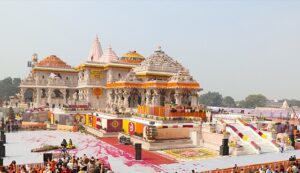
Ram, the primary god of Hinduism, is believed to have been born in the place where the temple is situated. Before: The Babri Masjid, built after the demolition of an existing un-Islamic building. The Supreme Court of India ruled in 2019 that the land in question is Hindu-only and can be used for the construction of a Ram temple. The construction of a mosque on secluded land will be done for Muslims. An un-Islamic structure was discovered beneath the Babri Masjid, as reported by the Archaeological Survey of India (ASI), which was cited by evidence in court. The presence was proven through evidence. The construction of the Ram temple was started on 5 August 2020 by implementing Bhoomipujan. The temple under construction is being preserved by Shri Ram Janmabhoomi Teerth Kshetra Trust. On January 22, 2024, the temple will be officially opened.
Viewing time scheduled:
After the installation of the new idol, devotees will be able to enjoy the darshan of both the idols in the Ram temple from January 23. The first shift of darshan is from 7 am to 11:30 am. The second shift has been made from 2 pm to 6:30 pm. As the number of devotees increases, the duration of darshan can be increased.
History
Ancient and medieval
The Hindu deity Ram is believed to be a reflection of Vishnu. In the epic of Ramayana, it is said that Ram was born in Ayodhya.
Babur’s attacks on temples in northern India during the 16th century resulted in the destruction of the temple. Afterward, the Mughals constructed the Babri Masjid, which is believed to be where Ram Janmabhoomi was born. Joseph Tiefenthaler, a Jesuit missionary, wrote the Latin book Descriptio India in 1767, which is considered the earliest known documentation of the mosque. The construction of the mosque, as per his account, involved demolishing both Ramkot temple and Bedi, where Ram was born.
Religious violence was first reported in 1853. In December 1858, the British government prohibited Hindus from performing puja (rituals) at the disputed location. A stage was erected outside the mosque for the rituals.
Morden Age
On December 22, the idols of Ram and Sita were placed inside the Babri Masjid, where followers began to gather from the following day. By 1950, the state had taken over the mosque (under Section 145 of the CrPC), and it allowed Hindus to worship there, not Muslims.
During the 1980s, the Vishwa Hindu Parishad (VHP), a group associated with the Sangh Parivar, opted to establish restitution for Hindus and construct sanctuaries for the young Ram (Ram Lalla) at this location. Did. The collection of bricks and money with “Jai Shri Ram” on it was initiated by VHP. Prime Minister Rajiv Gandhi granted VHP permission to lay the foundation stone, while Home Minister Buta Singh gave his formal approval to Ashok Singhal, the leader of VH. Initially, the government of India and that of Uttar Pradesh had agreed to place its foundation stone outside the dispute-ridden site. On 9 November 1989, a 200-liter (7-cubic-foot) trench was dug by dozens of VHP leaders and sadhus beside the disputed land to lay its groundwork. This is where the Sanctum Heiligorum’s lion gate was built. Afterward, VHP built a temple on the land next to the controversial mosque. Karsevaks, a group of 150,000 volunteers, were brought together by the VHP and Bharatiya Janata Party to organize a remembrance at the site on 6 December 1992. The rally turned into a battle, with the crowd overwhelming the security forces and demolishing the mosque.
The mosque’s demolition triggered several months of inter-communal violence between India’s Hindu and Muslim communities, leading to the deaths of approximately 2,000 individuals in Bombay (now Mumbai) and widespread rioting across the country. After the mosque was destroyed, The New York Times reported on 7 December 1992 that over 30 Hindu temples across Pakistan were attacked, some set ablaze, and one demolished. Hindu temples in Bangladesh were also targeted.
Five terrorists attacked the makeshift Ram temple in Ayodhya on 5 July 2005, at the site of the Babri Masjid that had been destroyed. Five individuals were fatally injured during the CRPF attack, and a civilian was killed in grenade attacks to break through the siege wall. The CRPF lost three individuals, two of whom were severely wounded by bullets.
The Archaeological Survey of India (ASI) conducted two archaeological excavations in 1978 and 2003, which revealed the presence of a Hindu temple. According to archaeologist KK Muhammad, the findings were undermined by left-wing historians. Over time, a number of disputes in title and law emerged due to the passage of the Acquisition of Certain Areas in Ayodhya Act in 1993. In 2019, the Supreme Court’s decision on the Ayodhya dispute led to the transfer of disputed land to Ram Temple’s construction, which was not established before. The trust was established with Shri Ram Janmabhoomi Teerth Kshetra as its official name. The Government of India approved the temple construction plan, as announced in the Parliament of England on 5 February 2020. Two days later, on 7 February, a plot of land across five acres was allotted for the construction of 22 new mosques in Dhannipur village, away from Ayodhya.
Architect
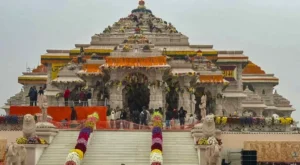
Ahmedabad-based Sompura family created the original Ram Temple design in 1988. For at least 15 generations, Sompura has designed over 100 other temples across the globe, including the Somnath Temple. The temple was designed by Chandrakant Sompura, with the assistance of his two sons, Nikhil Sommura and Ashish Sompra. In 2020, Sompura created a new design that had some modifications from the original, as per Hindu texts, Vastu Shastra, and Shilpa Shatra. The temple’s dimensions will be 250 feet wide, 380 feet long, and 161 feet (49 m) high. When completed, it will become the third-largest Hindu temple in existence. The Gurjara-Chalukya style of Nagara style architecture, a type of Hindu temple architecture that is predominantly found in northern India, forms its design. The Prayag Kumbh Mela in 2019 featured a model of the proposed temple. A three-story platform will serve as the temple’s primary building structure. The sanctum horum and its entrance will have five pavilions located in the middle. The mandap will have three pieces, one for Kudu, dance, and color, and two pieces for kirtan and prayer. Shining shikhara is present in the Nagara-style pavilions.

The building will consist of 366 columns. Each pillar will have 16 idols, consisting of Shiva’s incarnations, Dashavatara, Yoginis, and Saraswati. The stairs will measure 16 feet (4 m). 9 meters. The design of Vishnu’s temples will include an octagonal sanctum titled rectum. The temple is set to be built on a 10-acre (0. 57 acres (0. The site will be used as a prayer hall, lecture hall (on an area of 23 km2), educational center, museum, cafeteria, etc. will be built on campus. More than 70,000 people are expected to visit the site, as stated by the temple committee. Larsen & Toubro decided to provide free consultation and construction services for the temple project. The Central Building Research Institute, National Geophysical Research Institute, and IITs Bombay, Guwahati, and Madras are collaborating in the areas of soil testing, concrete, and design. Construction will use 600,000 sandstone mined from Banja in Rajasthan. The temple will be made without any iron, and the stone blocks will need to be bound with ten thousand copper plates. By sending soil to the Ram Janmabhoomi, Thailand is making a symbolic contribution to his temple inauguration in remembrance of its historic act.
God
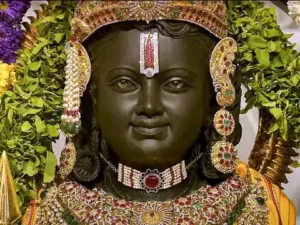
The attire of Ram Lalla was crafted by his idol’s fourth-generation tailors, Bhagwat Prasad and Shankar Lal. The disputed site case in 1989 involved Ram Lalla, who was considered a “judicial person” by law. He was represented by Triloki Nath Pandey, a senior VHP leader who is considered Ram Lalla’s closest humanitarian friend. Temples devoted to Surya, Ganesha, Shiva, Durga Vishnu and Brahma are included in the temple trust’s final blueprint. In the sanctum holla of the temple, there will be two Ramlala idols (one being 5 years old).
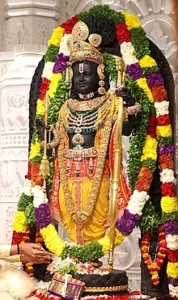
On 29 December 2023, the Ayodhya Ram temple cast ballots to select an idol of Ram Lalla. Karnataka sculptor Arun Yogiraj was responsible for the creation of Ram’s idol.
Ayodhya in Night
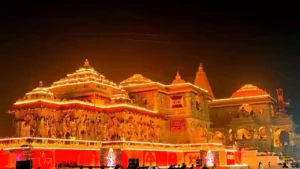
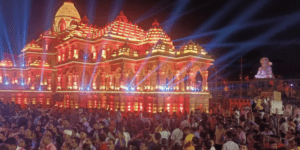
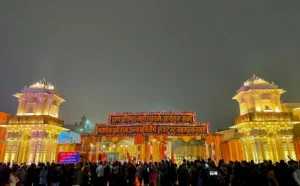
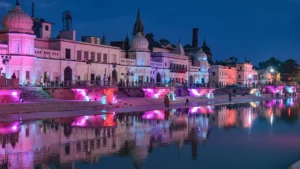

1 thought on “Ayodhya Ram Temple”